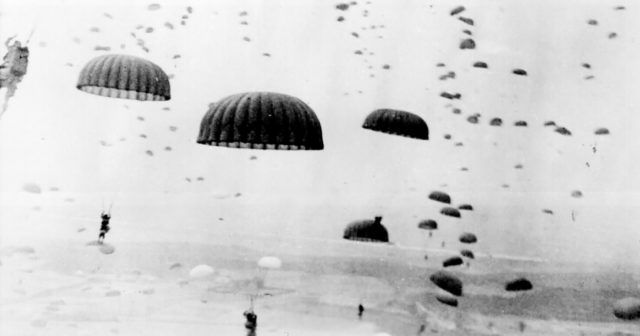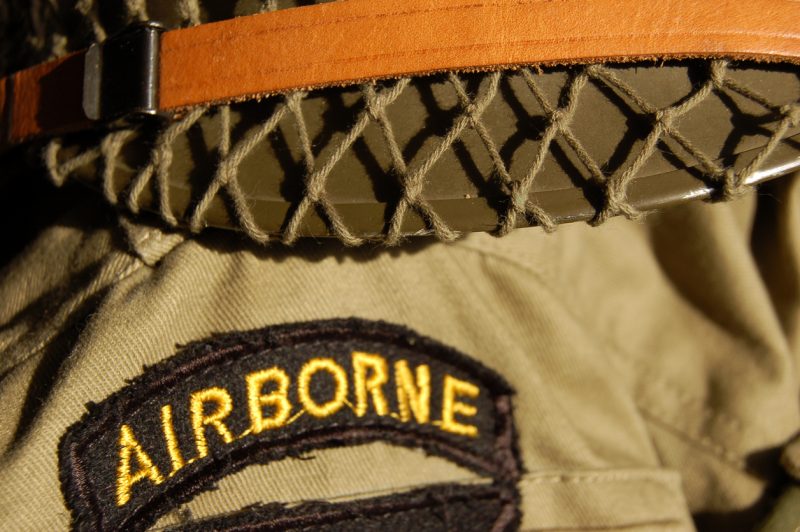With 180 photographs, maps, and illustrations, The Airborne In World War II is an accessible account of the remarkable men who served our country during WWII and the battles that they fought.
From D-Day, Operation Market Garden and Battle of the Bulge the US Airborne divisions were integral at all these major points of World War II. Haskew features their equipment, division structure, and uniforms, as well as first-hand accounts to follow the airborne divisions from their establishment and initial training through to their final, momentous missions in the Pacific.
Some of the moments highlighted in The Airborne In World War II include:
- Staff Sergeant Harrison Summers’ single-handed attack on a German strongpoint on D-day
- The 504th Parachute Infantry Regiment’s amphibious assault across the Waal River using small canvas craft
- The 101st Airborne’s dogged defense of Bastogne
- The 82nd Airborne’s General James Gavin, nicknamed “Jumping General” because of his wiliness to make combat jumps with his men
- The establishment of the 555th, the all-black airborne battalion
- The fabled exploits of the “Filthy Thirteen,” the original inspiration for the 1967 movie The Dirty Dozen
- The campaigns of the 11th Airborne Division, with found in the Pacific Theater
Divided chronologically by chapter, THE AIRBORNE IN WORLD WAR II charts the combat history of the American Airborne from their first drops into North Africa, Sicily, and Italy through the invasion of Normandy to the assault and defeat of Nazi Germany.

Exclusive Excerpt:
When the 82nd Airborne Division was withdrawn from the Mediterranean Theater, the 504th Parachute Infantry Regiment remained behind. Collectively the 504th PIR, the 376th Parachute Field Artillery Battalion, and Company C, 307th Parachute Engineers were designated the 504th Parachute Combat Team.
Since the landings at Salerno, the paratroopers of the 504th PIR had fought as infantry during the rugged, costly advance of the Allied Fifth Army toward Rome. On January 4, 1944, the 504th was pulled from the front line to prepare for Operation Shingle, an amphibious operation that would land Allied troops at Anzio, 35 miles (56km) south of Rome, to outflank the stubborn German defenses at the Gustav Line further south.
Although the plan for the Anzio landings was risky, the logic appeared sound. Allied troops had made little headway against the Gustav Line, a string of fortifications in the mountains of the Italian boot that stretched from the Tyrrhenian Sea in the west to the Adriatic in the east. Stout enemy defenses at the town of Cassino had stymied the advance of the Fifth Army.
Originally, the 504th PIR had been scheduled to parachute into the Anzio area near Aprilia and capture the crossroads at Campoleone on January 22; however, probably influenced by the losses during the Sicily and Salerno drops, Operation Shingle planners shelved the idea. The 504th landed at Anzio from the sea, capturing the town of Borgo Piave on the 24th before German artillery and tanks forced them to withdraw. The regiment then held defensive positions along the Mussolini Canal until was relieved on January 28.
Following the pullout, the 3rd Battalion, 504th, was assigned to the 1st Armored Division and became the first U.S. airborne unit to receive the Presidential Unit Citation for its heroic stand against a German counterattack. Rather than a lightning strike, the Anzio operation devolved into a stalemate that was only broken months later in an all-out offensive known as Operation Diadem. The 3rd Battalion eventually rejoined its parent regiment, and the troopers continued to harass the enemy. One German general ruefully referred to the men of the 504th as “Devils in Baggy Pants,” a nickname that has remained with the unit.
In March 1944, the 504th PIR was withdrawn from the Mediterranean, and on April 22 the troopship carrying the men arrived in Liverpool. The 82nd Airborne Division band was there to greet its returning battalion with martial tunes. While the anxious men of the 504th believed that they would rejoin the 82nd Airborne for the coming invasion of Western Europe, replacements were scarce and training time was short. A small number of 504th men were reassigned and took part in Operation Overlord as pathfinders.
Excerpted from THE AIRBORNE IN WORLD WAR II: An Illustrated History of America’s Paratroopers in Action by Michael E. Haskew.
Copyright © 2016 by Amber Books Ltd and reprinted by permission of Thomas Dunne Books, an imprint of St. Martin’s Press.
